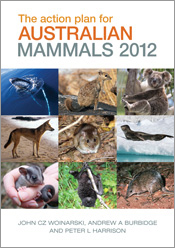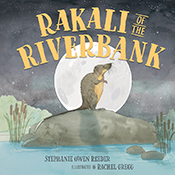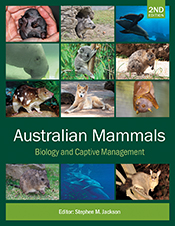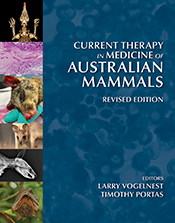The Action Plan for Australian Mammals 2012
By: John CZ Woinarski, Andrew A Burbidge, Peter L Harrison
A comprehensive snapshot of the current conservation status of Australian mammals.
The Action Plan for Australian Mammals 2012 is the first review to assess the conservation status of all Australian mammals. It complements The Action Plan for Australian Birds 2010 (Garnett et al. 2011, CSIRO Publishing), and although the number of Australian mammal taxa is marginally fewer than for birds, the proportion of endemic, extinct and threatened mammal taxa is far greater. These authoritative reviews represent an important foundation for understanding the current status, fate and future of the nature of Australia. + Full description
This book considers all species and subspecies of Australian mammals, including those of external territories and territorial seas. For all the mammal taxa (about 300 species and subspecies) considered Extinct, Threatened, Near Threatened or Data Deficient, the size and trend of their population is presented along with information on geographic range and trend, and relevant biological and ecological data. The book also presents the current conservation status of each taxon under Australian legislation, what additional information is needed for managers, and the required management actions. Recovery plans, where they exist, are evaluated.
The voluntary participation of more than 200 mammal experts has ensured that the conservation status and information are as accurate as possible, and allowed considerable unpublished data to be included. All accounts include maps based on the latest data from Australian state and territory agencies, from published scientific literature and other sources.
The Action Plan concludes that 29 Australian mammal species have become extinct and 63 species are threatened and require urgent conservation action. However, it also shows that, where guided by sound knowledge, management capability and resourcing, and longer-term commitment, there have been some notable conservation success stories, and the conservation status of some species has greatly improved over the past few decades.
The Action Plan for Australian Mammals 2012 makes a major contribution to the conservation of a wonderful legacy that is a significant part of Australia’s heritage. For such a legacy to endure, our society must be more aware of and empathetic with our distinctively Australian environment, and particularly its marvellous mammal fauna; relevant information must be readily accessible; environmental policy and law must be based on sound evidence; those with responsibility for environmental management must be aware of what priority actions they should take; the urgency for action (and consequences of inaction) must be clear; and the opportunity for hope and success must be recognised. It is in this spirit that this account is offered.
Winner of a 2015 Whitley Awards Certificate of Commendation for Zoological Resource.
- Short descriptionNews
No longer available in a print edition.
Reviews
"Invaluable for those interested in the protection of Australian wildlife, and a great resource for anyone studying the ecology of mammals Down Under."
J. L. Hunt, Choice, June 2015, vol. 52, no. 10
Details
ePDF | June 2014ISBN: 9780643108745
Publisher: CSIRO Publishing
Available from eRetailers
ePUB | June 2014
ISBN: 9780643108752
Publisher: CSIRO Publishing
Available from eRetailers
Features
- Provides a benchmark for the assessment of trends in the conservation status of a major component of Australian biodiversity.
- Helps to re-calibrate the somewhat dated official lists of Australian threatened mammals.
- Highlights successes in environmental management and pinpoints major areas of ongoing failure or shortcomings.
- Accessible guide for environmental managers.
Contents
SummaryAbout the authors
Acknowledgements
1. Introduction
2. A list of native Australian mammal species and subspecies
3. Evaluation of taxa that have been translocated to ‘mainland islands’ and continental islands
4. Status assigned to every Australian mammal species and subspecies
5. Taxon conservation summaries
6. Analysis: the status and trends of Australian mammals
7. Conclusions
Appendix A. Accounts for taxa that were Not Evaluated
Appendix B. Calculation of taxonomic distinctiveness
Index
View the full table of contents (PDF).
Authors
John Woinarski has been involved in research, management, advocacy and policy relating to biodiversity conservation, particularly in relation to threatened species, in Australia since the 1970s. Much of this work has been undertaken in northern Australia, with a particular focus on threatened mammal species. He has received numerous awards, including the Eureka Prize, the Australian Natural History Medallion, and the Serventy Medal for lifetime contribution to Australian ornithology. He is currently Professor in the Research Institute for the Environment and Livelihoods, Charles Darwin University.Andrew Burbidge worked as a research scientist and manager in Western Australian government conservation departments from 1968 to 2002, where he had a strong focus on threatened species. His research and management also included conservation reserve design and selection, biological survey, island research and management including eradication of invasive mammals and biosecurity, indigenous oral history of mammals and fire ecology, and translocations. He is currently chair of the Western Australian Threatened Species Scientific Committee. Since 2002 he has worked part time as a consultant conservation biologist.
Peter Harrison has worked as a marine ecologist for more than 30 years and is Professor and Director of the Marine Ecology Research Centre at Southern Cross University. His diverse research and teaching interests encompass marine mammals to corals, with a focus on linking research findings to improved conservation and management outcomes. He was awarded a joint Eureka Prize for environmental research. He has been a member of the Threatened Species Scientific Committee since 2005, and is a member of the NSW Marine Fauna Advisory Group, the Sea World Research and Rescue Foundation Scientific Committee, the Port Curtis and Port Alma Ecosystem Research and Monitoring Program Advisory Panel, and the South Pacific Whale Research Consortium.








